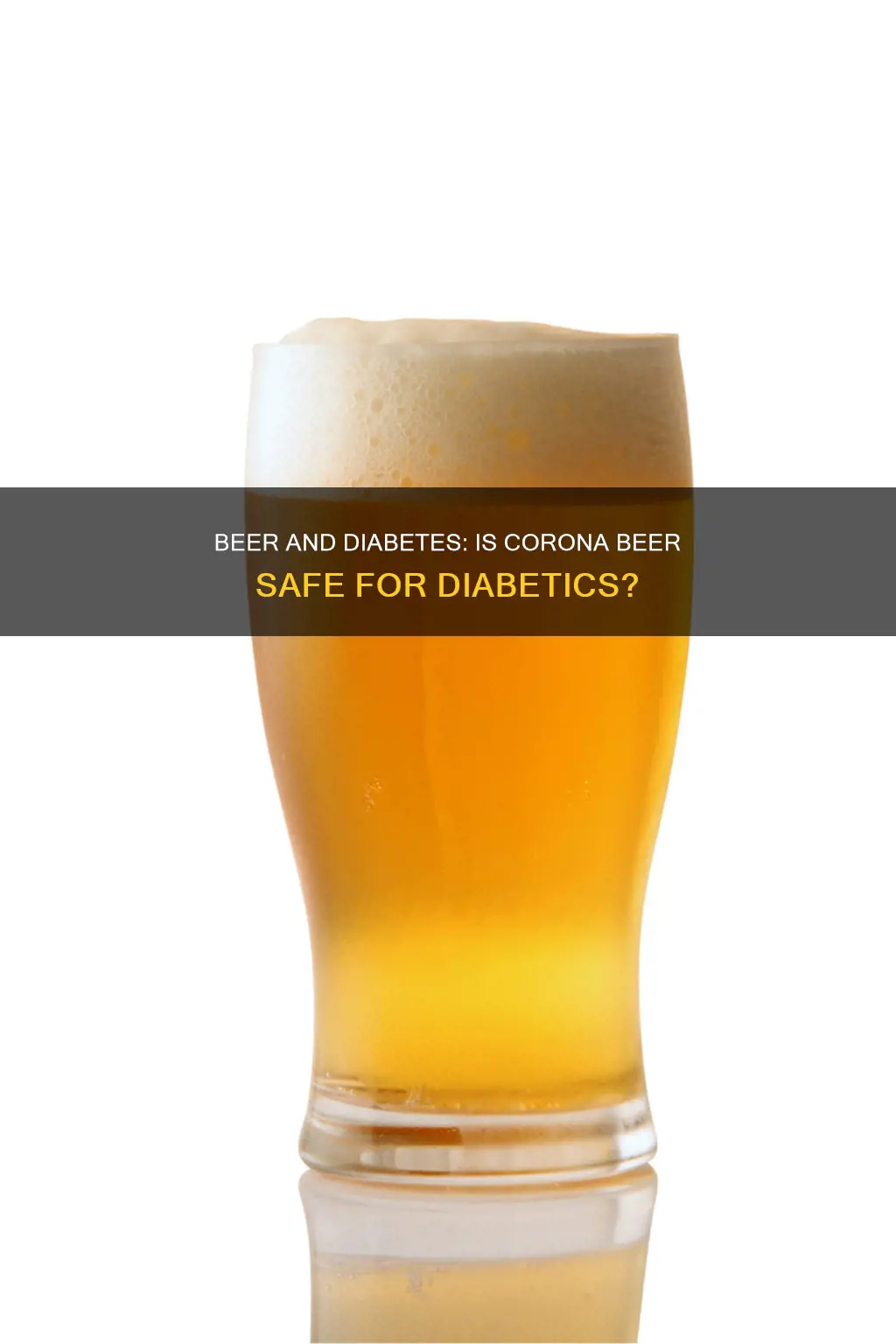
People with diabetes can still enjoy a drink, but they need to be mindful of how alcohol affects their blood sugar levels. Beer is a significant source of carbohydrates, so it can impact blood sugar. It can also be high in calories, and some types of beer can be higher in alcohol too. The liver prioritises clearing alcohol from the body, so drinking alcohol can slow down carb metabolism, potentially leading to low blood sugar (hypoglycaemia).
Drinking in moderation and monitoring blood sugar levels are good ways to ensure diabetics won't experience hypoglycaemia. It's also best to drink with food and to stay hydrated by drinking water.
So, can diabetics drink Corona beer? Well, Corona Premier is Corona's lowest-calorie beer, launched in 2018. It has 0.7 grams of protein, 2.6 grams of carbohydrates, and a 4% ABV. A 330ml bottle has 90 calories, which is less than Corona Light.
| Characteristics | Values |
|---|---|
| Alcohol content | 4.0% ABV |
| Carbohydrates | 2.6g per 330ml |
| Calories | 90 per 330ml |
| Protein | 0.7g per 330ml |
What You'll Learn

Diabetics can drink Corona beer in moderation
The 2020-2025 Dietary Guidelines for Americans defines moderate alcohol intake as up to one drink per day for women and up to two drinks per day for men. In the case of beer, one 12-ounce can is considered one drink. If you stick to these guidelines, consuming alcohol is generally safe when living with diabetes.
Beer is a significant source of carbohydrates, so it can impact blood sugar levels. It can also be high in calories, so drinking beer may contribute to weight gain over time. Additionally, because the liver prioritises clearing alcohol from the body, drinking alcohol can slow down carb metabolism, potentially leading to low blood sugar (hypoglycaemia).
Drinking any alcohol when taking diabetes medications can exacerbate this effect. It is therefore essential to be mindful when consuming alcoholic beverages like beer when you have diabetes. It is recommended that diabetics do not drink on an empty stomach and that they have a low-carbohydrate snack with their drink. It is also important to stay hydrated by drinking water with beer.
There are many light and low-carb beer options that are most appropriate for people with diabetes. These include Miller Lite, Coors Light, Budweiser Select 55, and Corona Premier. Corona Premier is Corona's lowest-calorie beer and is the upgraded version of their crisp pilsner beer, Corona Light. It has 0.7 grams of protein, 2.6 grams of carbohydrates, and just 4.0 percent ABV. A 330ml bottle of Corona Premier has 90 calories, which is less than Corona Light.
Breastfeeding and Beer: How Long Should You Wait?
You may want to see also

Beer is a significant source of carbohydrates
Beer is typically higher in carbohydrates than other alcoholic drinks like wine or spirits. However, the carb content of beers can vary widely depending on the type of beer. "Light" beers have the fewest carbs, usually five grams or less per serving. They also tend to be lower in alcohol content. Hoppy craft beers like IPAs and stouts tend to be much higher in carbohydrates, usually containing 15 grams or more per serving. They also tend to be higher in calories and alcohol, so it's best to stick to just one serving.
Beer bottles and cans do not typically come with a nutrition facts label, so it can be hard to know how many calories and carbohydrates are in a serving. You can find nutrition information for some of the major beer brands on websites like www.calorieking.com. Beers that are under 100 calories and have no more than five grams of carbohydrates per 12-ounce (360-millilitre) serving include Beck's Premier Light.
Some popular low-carb beer options include Miller Lite, an American-style light lager made with barley malt and corn syrup. It contains only 3.2 grams of carbohydrates in a standard 12-ounce can or bottle, compared to 12 grams for the same serving in regular Miller beers. Coors Light is another light lager that provides five grams of carbohydrates per 12-ounce bottle. Bud Light is another low-carb option, providing fewer than five grams of carbs per serving.
Lovastatin and Beer: A Safe Mix?
You may want to see also

Alcohol competes with the liver's ability to make glucose
Alcohol can inhibit the liver's ability to regulate glucose levels. The liver plays a crucial role in maintaining healthy blood sugar levels by storing and producing glucose. It steadily releases glucose into the blood throughout the day, a process known as gluconeogenesis. When the liver is busy breaking down alcohol, it prioritises this task, potentially releasing insufficient glucose to keep blood sugar levels stable. This can lead to hypoglycaemia, especially in people with diabetes who take insulin or medications like sulfonylureas that increase insulin production.
The liver's impairment by alcohol can last for several hours after drinking, so it's important to be aware of this, especially when drinking in the evening before bed. If people with diabetes, particularly those taking insulin, don't take additional carbohydrates before sleeping, they risk experiencing hypoglycaemia overnight.
Additionally, some alcoholic drinks like beers, ciders, and liqueurs contain carbohydrates, which may cause an initial rise in blood sugar levels. However, later on, people may become more susceptible to low blood glucose levels due to alcohol's inhibitory effect on the liver's glucose production.
To prevent hypoglycaemia after drinking alcohol, it's recommended to monitor blood glucose levels regularly and be cautious when taking insulin. It's also crucial to take sufficient carbohydrates before bed and to test blood glucose levels before and after sleeping.
Low-Carb Diet and Beer: Is It Possible?
You may want to see also

Drinking on an empty stomach should be avoided
People with diabetes can drink alcohol, including beer, in moderation. However, it is important to be mindful of how alcohol consumption can affect blood sugar levels. Beer is a significant source of carbohydrates, and it can be high in calories, so drinking beer may contribute to weight gain over time. Additionally, because the liver prioritizes clearing alcohol from the body, drinking alcohol can slow down carb metabolism, potentially leading to low blood sugar (hypoglycemia).
To prevent hypoglycemia, it is important to eat before drinking and to keep food handy while drinking. It is also crucial to monitor your blood sugar levels during and after drinking. Alcohol consumption recommendations are the same for people with diabetes as for the general population: no more than one drink per day for women and up to two drinks per day for men. It is also important to stay hydrated by drinking water with your beer.
If you are taking insulin or medications that increase the risk of hypoglycemia, such as sulfonylureas, it is especially important to avoid drinking on an empty stomach. In addition, if you have other health conditions, such as liver disease, kidney disease, or neuropathy, it is recommended to consult your healthcare provider about the safety of drinking alcohol.
Understanding Beer Portion Sizes: Standard Drink Explained
You may want to see also

Beer is higher in carbohydrates than other alcoholic drinks
Beer is typically higher in carbohydrates than other alcoholic drinks like wine or spirits. However, the carb content of beers can vary depending on the type of beer. "Light" beers tend to have the least amount of carbs, usually 5 grams or less per serving, and are also lower in alcohol content. On the other hand, hoppy craft beers like IPAs and stouts tend to be much higher in carbs, typically containing 15 grams or more per serving. They also tend to be higher in calories and alcohol content.
Regular lagers typically vary in carbohydrate content from about 10 to 15 grams per pint, while some light beers may have less than 10 grams of carbs per pint, and some have less than 5 grams. Stouts, porters, and Guinness are on the higher end of the carbohydrate spectrum among beers, with upwards of 20 grams of carbohydrates per pint. Real ales typically have a carbohydrate content of 10 to 20 grams of carbs per pint, but this can vary depending on additional flavourings such as extra sugar or honey.
When it comes to choosing a low-carb alcoholic beverage, wine and light beer are relatively low in carbs, with 3-4 grams per serving. Pure forms of liquor like rum, whiskey, gin, and vodka are completely carb-free. It is important to note that while moderate alcohol consumption (no more than one to two drinks per day) is generally considered safe for people with diabetes, it is always a good idea to consult with a healthcare professional to determine what is suitable for your specific needs.
Managing High Blood Sugar: Beer's Impact and Your Health
You may want to see also
Frequently asked questions
Yes, diabetics can drink beer, but it is not without risks. Beer is a significant source of carbohydrates, so it can impact blood sugar. Beer can also be high in calories and alcohol. It is recommended that diabetics limit their intake to one or two 12-ounce beers per day.
The healthiest type of beer for diabetics to drink is generally one with lower alcohol content and reduced carbohydrates. Light beers, such as Miller Lite and Coors Light, are good options. Low-carb beers, such as Budweiser Select 55 and Corona Premier, are also suitable for diabetics.
Beer can cause blood sugar levels in diabetics to fluctuate. Some beers lead to a drop in blood sugar levels, while others cause a gradual increase. It is important for diabetics to monitor their blood sugar levels when drinking beer.
Yes, diabetics who take insulin or other diabetes medications should be especially cautious when drinking beer, as it can increase the risk of hypoglycemia (low blood sugar). It is recommended that diabetics do not drink beer on an empty stomach and that they drink in moderation.







